Interior Space + Fuel Economy
The Prius V wagon is the largest in Toyota’s line of Prius hybrid cars that include the Prius Liftback, Prius c and the all-new 2017 Prius Prime plug-in. Each has its own value and offers something a bit different, but when combined, they add-up to the best-selling hybrid car line in the United States.
Larger and roomier than its siblings, the 2017 Toyota Prius V is not really a crossover or small SUV—the hottest sales segment of the auto market—so it may get overlooked and not considered by shoppers. This should not be the case, as the Prius V is unique being a hybrid wagon that offers great fuel economy and lots of room for your stuff.
Drivetrain
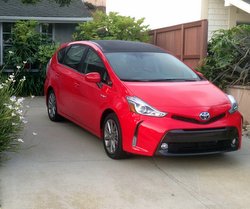
The front-wheel drive 2017 Prius V is powered by a parallel hybrid drivetrain, which Toyota calls their Hybrid Synergy Drive. In the parallel hybrid system the electric motor can power the car by itself, the gas engine can power the car by itself, or they can power the car together.
The Hybrid Synergy Drive system comprises a 1.8-liter four-cylinder gasoline engine that makes 98 horsepower, but with the two electric motors the combination produces 134 hp. The power gets to the front wheels through the continuously variable transmission (CVT), delivering 43 city/39 highway/41 mpg combined. In 308 miles of 65-percent highway/35-percent city driving, Clean Fleet Report achieved 40.4 mpg.
Driving Experience: On the Road
The four-door plus liftgate Prius V wagon weighs in at 3,340 lbs., which is well-distributed due to the under-seat battery placement. The result is a low center of gravity, which contributed to a good driving experience. The V felt balanced, with the freeway confidence level being quite high, especially when passed by a semi-truck or in a windy mountain pass.
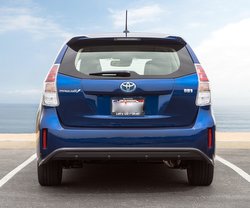
A smooth and quiet highway ride is partly due to the electrically power-assisted rack-and-pinion steering, the front MacPherson struts with stabilizer bar and rear Torsion beam suspension. Clean Fleet Report was driving the Prius V Five, which had 17-inch alloy wheels and all-season tires. This combination helped the car corner adequately, but there was no sense of feeling sporty. If you are considering buying a Prius as a sporty car, you need to be looking elsewhere. There’s no head snapping going on with 0 – 60 in 10+ seconds. But getting real and being fair, fuel economy and carrying capacity for all your stuff is what the V is all about.
Pure electric driving is limited to a few miles and necessitates a very soft touch to the accelerator pedal. Even the slightest pressure seamlessly kicks-in the gasoline engine, which makes driving the Prius V a frustrating slow-speed and around-town venture. One nice feature is that when stopped in traffic or at a light, the engine shuts off to save fuel.
Driving Experience: Interior
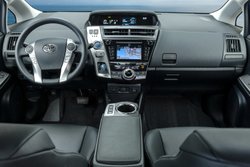
The 2017 Toyota Prius V has a spacious interior that is laid-out nicely. Passenger comfort is excellent with mega legroom. The front bucket seats are separated by a padded console with storage, and a center stack where the heartbeat for information and entertainment are found. The gear selector poking out of the lower dash is conveniently placed as it leaves ample room, and an uncluttered look, on the center console. The tilt/telescopic steering wheel has the usual control buttons (audio, phone, cruise control, climate, Bluetooth, etc.) and includes the ability to switch between fuel and battery (hybrid) gauges. Another unique design is the gauge placement, which is found on the top-center of the dash. This means no gauges, as in zero, are directly in front of the driver. It does not take much effort to look 10 degrees to the right at all times, but it is odd. Maybe a heads-up display would be a nice addition.
A comfortable, vegan interior
The Prius V comfortably seats four full-size adults or five for short trips. All passengers have good sightlines front and rear, due to a raised sitting position for the rear passengers. Our Five model came with heated, SofTex trimmed seats with a power eight-way adjustable driver’s seat with power lumbar. The front passenger seat is four-way manually adjustable (with no lumbar adjustment) and has a convenient fold-flat feature. SofTex is a synthetic material designed for long wear, being soft to the touch, resisting spills and is easy to clean. And for the vegans out there, there are no animal-based materials used in the SofTex manufacturing process.
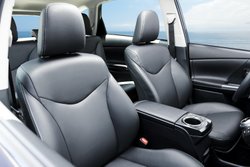
The front bucket seats could use more thigh bolstering, but otherwise were easy to settle into for a long trip without leg and back fatigue. Toyota has provided five cup holders in the cabin, with 12V power outlets in the front and cargo areas. One really nice feature not usually found in a car of this size is that the rear seat reclines. Not flat for sleeping, but certainly enough to doze off on a long road trip.
Where the 2017 Toyota Prius V really shines is the ample storage space, with or without the 60/40 rear seats folded flat. Lay them down for long items, utilizing the fold-flat front passenger bucket seat, and the V is very versatile whether you are antiquing, made a garden center run or hitting the beach with your surfboard or lake with a kayak. The panoramic moonroof was a nice touch.
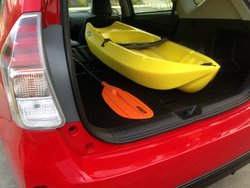
There are four Prius V models: Two, Three, Four and Five. Clean Fleet Report drove the Five for a week with the optional Advanced Tech Package. Features on our Five included a 6.1-inch high-definition touch-screen display with navigation, back-up camera and Toyota’s Entune App Suite. The Entune premium service, which is complimentary for three years, includes Bing, iHeartRadio, MovieTickets.com, OpenTable and Pandora, XM Data Services, iNavTraffic, NavWeather, fuel, sports and stocks.
The eight JBL Greenedge speakers delivered crisp sound for the JBL audio system that had AM/FM CD player with MP3/WMA playback capability. It came with SiriusXM (which includes a 90-day trial subscription), HD AM Radio with an auxiliary audio jack, USB port with iPod connectivity, Siri EyesFree, hands-free phone, advanced voice recognition and music streaming via Bluetooth wireless technology.
Driving Experience: Exterior
The Prius V wagon shape has a balanced silhouette. Starting with the long, sloping line from the front Toyota emblem to the highest point on the roof, which lies at the B pillar, the V has a tall stance and slab sides. This design allows for the spacious interior for passengers and cargo.
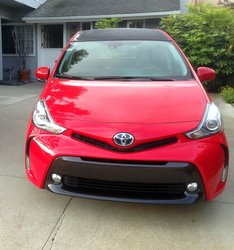
Safety and Convenience
The 2017 Toyota Prius V is well-equipped for safety and convenience with remote keyless entry, power door locks, tire pressure monitoring system, projector beam halogen headlights, seven airbags, heated power outside mirrors, rear window wiper, hill assist, vehicle stability, traction control and ABS with brake assist and smart stop technology. Additional safety features include lane departure alert, dynamic cruise control, pre-collision and parking guidance system and Toyota’s Safety Connect service, which has many of the features found on General Motor’s OnStar service.
Pricing and Warranties
The 2017 Prius V comes in four models; Clean Fleet Report drove the model Five with one optional package. The MSRP for our test car was $34,270. All prices listed are MSRP and exclude the $835 delivery, processing and handling fee.
Model Two $26,675
Model Three $28.060
Model Four $29,695
Model Five $30,935
The 2017 Prius V comes with these warranties:
- Hybrid-related Component Coverage – Eight years/100,000 milea
- Comprehensive – Three years/36,000 miles
- Powertrain – Five years/60,000 miles
- Corrosion Perforation – Five years/Unlimited miles
Observations: 2017 Toyota Prius V
The bottom line is that the 2017 Toyota Prius V has more competition now than in 2011 when it was launched. Heck, even within Toyota there is the RAV4 Hybrid that easily outsells the Prius V. So what is the appeal to a hybrid that is more wagon than SUV or crossover?
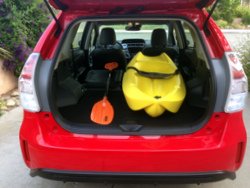
Consider that the 2017 Toyota Prius V is not a SUV or crossover. This small wagon has the appeal of getting into tight spaces with a nice blend of fuel economy and station wagon handiness. The cargo-stowing ability of the Prius V exceeds most crossovers, ranking it high as a utility vehicle.
The reliability of the Prius, and the status of being a member of Toyota’s market-leading hybrid family, should give you confidence that this car will be in your garage for many, many years.
Whatever you end up buying, enjoy your new car and as always, Happy Driving!
Related Stories You Might Enjoy
Road Test: 2017 Toyota RAV4 Hybrid
Road Test: 2017 Toyota Prius Prime
Road Test: 2016 Toyota Prius Liftback
Disclosure:
Clean Fleet Report is loaned free test vehicles from automakers to evaluate, typically for a week at a time. Our road tests are based on this one-week drive of a new vehicle. Because of this we don’t address issues such as long-term reliability or total cost of ownership. In addition we are often invited to manufacturer events highlighting new vehicles or technology. As part of these events we may be offered free transportation, lodging or meals. We do our best to present our unvarnished evaluations of vehicles and news irrespective of these inducements.
Our focus is on vehicles that offer the best fuel economy in their class. We also feature those that are among the top mpg vehicles in their class. In addition, we aim to offer reviews and news on advanced technology and the alternative fuel vehicle market. We welcome any feedback from vehicle owners and are dedicated to providing a forum for alternative viewpoints. Please let us know your views at publisher@cleanfleetreport.com.

6 thoughts on “Road Test: 2017 Toyota Prius V”